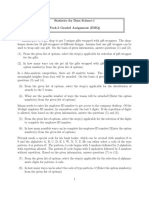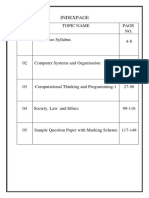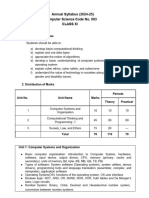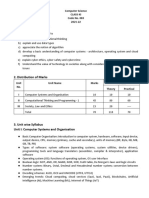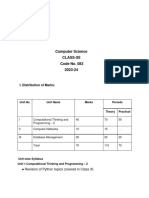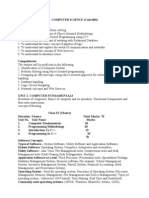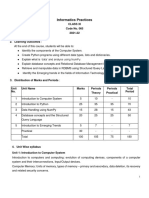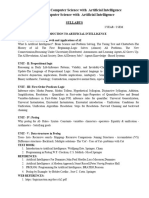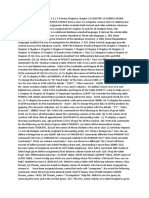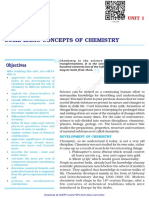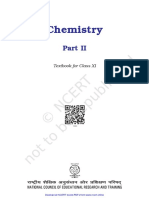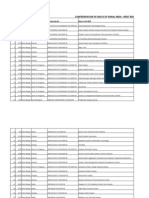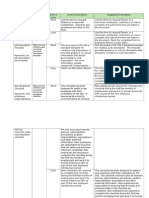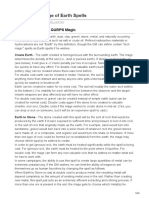0 ratings0% found this document useful (0 votes)
34 viewsComputer Science Vportions
Computer Science Vportions
Uploaded by
rekha_1234This document outlines the curriculum for the final exam in Computer Science (Revised) for Class XI. It covers key topics like computer organization, number systems, programming concepts in Python, and computational thinking. The exam will test students on their understanding of basic computer components, Boolean logic, encoding schemes, and operating systems. It will also evaluate students' programming abilities in Python, including working with variables, data types, operators, conditional and iterative statements, and string, list, tuple and dictionary manipulation. Societal and ethical issues related to technology like cyber safety, intellectual property, and cybercrime are also included. Practical Python programs on various numerical and logical problems are provided for hands-on practice.
Copyright:
© All Rights Reserved
Available Formats
Download as DOCX, PDF, TXT or read online from Scribd
Computer Science Vportions
Computer Science Vportions
Uploaded by
rekha_12340 ratings0% found this document useful (0 votes)
34 views6 pagesThis document outlines the curriculum for the final exam in Computer Science (Revised) for Class XI. It covers key topics like computer organization, number systems, programming concepts in Python, and computational thinking. The exam will test students on their understanding of basic computer components, Boolean logic, encoding schemes, and operating systems. It will also evaluate students' programming abilities in Python, including working with variables, data types, operators, conditional and iterative statements, and string, list, tuple and dictionary manipulation. Societal and ethical issues related to technology like cyber safety, intellectual property, and cybercrime are also included. Practical Python programs on various numerical and logical problems are provided for hands-on practice.
Original Description:
portion
Original Title
Computer Science vportions
Copyright
© © All Rights Reserved
Available Formats
DOCX, PDF, TXT or read online from Scribd
Share this document
Did you find this document useful?
Is this content inappropriate?
This document outlines the curriculum for the final exam in Computer Science (Revised) for Class XI. It covers key topics like computer organization, number systems, programming concepts in Python, and computational thinking. The exam will test students on their understanding of basic computer components, Boolean logic, encoding schemes, and operating systems. It will also evaluate students' programming abilities in Python, including working with variables, data types, operators, conditional and iterative statements, and string, list, tuple and dictionary manipulation. Societal and ethical issues related to technology like cyber safety, intellectual property, and cybercrime are also included. Practical Python programs on various numerical and logical problems are provided for hands-on practice.
Copyright:
© All Rights Reserved
Available Formats
Download as DOCX, PDF, TXT or read online from Scribd
Download as docx, pdf, or txt
0 ratings0% found this document useful (0 votes)
34 views6 pagesComputer Science Vportions
Computer Science Vportions
Uploaded by
rekha_1234This document outlines the curriculum for the final exam in Computer Science (Revised) for Class XI. It covers key topics like computer organization, number systems, programming concepts in Python, and computational thinking. The exam will test students on their understanding of basic computer components, Boolean logic, encoding schemes, and operating systems. It will also evaluate students' programming abilities in Python, including working with variables, data types, operators, conditional and iterative statements, and string, list, tuple and dictionary manipulation. Societal and ethical issues related to technology like cyber safety, intellectual property, and cybercrime are also included. Practical Python programs on various numerical and logical problems are provided for hands-on practice.
Copyright:
© All Rights Reserved
Available Formats
Download as DOCX, PDF, TXT or read online from Scribd
Download as docx, pdf, or txt
You are on page 1of 6
Computer Science
(Revised)
CLASS-XI
Code No. 083
2020-21
Ability to understand and apply basic computational thinking.
Ability to understand the notion of data types and data structures and apply in different situations.
Ability to appreciate the notion of an algorithm and apply its structure including how algorithms
handle corner cases.
Ability to develop a basic understanding of computer systems -
architecture, operating system, mobile and cloud computing.
Ability to work in the cyber world with understanding of cyber ethics, cyber safety and cybercrime
Ability to make use the value of technology in societies, gender and disability issues and the
technology behind biometric ids.
Unit I: Computer Systems and Organisation
● Basic computer organisation: description of a computer system and
mobile system, CPU, memory, hard disk, I/O, battery.
● Types of software: Application software, System software and Utility
software.
● Memory Units: bit, byte, MB, GB, TB, and PB.
● Boolean logic: NOT, AND, OR, NAND, NOR, XOR, NOT, truth tables and
De Morgan’s laws, Logic circuits
● Number System: numbers in base 2, 8, 16 and binary addition.
● Encoding Schemes : ASCII, ISCII and Unicode
● Concept of Compiler and Interpreter
● Operating System (OS) - need for an operating system, brief introduction
to functions of OS, user interface
Unit II: Computational Thinking and Programming – 1
Introduction to Problem solving: Problem solving cycle - Analysing a problem,
designing algorithms and representation of algorithm using flowchart and
pseudo-code.
Familiarization with the basics of Python programming: a simple “hello world"
program, the process of writing a program (Interactive & Script mode),
running it and print statements; simple data-types: integer, float and string.
● Features of Python, Python Character Set, Token & Identifiers, Keywords,
Literals, Delimiters, Operators.
● Comments: (Single line & Multiline/ Continuation statements), Clarity &
Simplification of expression
● Introduce the notion of a variable and methods to manipulate it (concept of
L-value and R-value even if not taught explicitly).
● Knowledge of data types and operators: accepting input from the console,
assignment statement, expressions, operators and their precedence.
● Operators & types: Binary operators-Arithmetic, Relational Operators,
Logical Operators, Augmented Assignment Operators.
● Execution of a program, errors- syntax error, run-time error and logical
error.
● Conditional statements: if, if-else, if-elif-else; simple programs: e.g.:
absolute value, sort 3 numbers and divisibility of a number.
● Notion of iterative computation and control flow: for(range(),len()), while,
using flowcharts, suggested programs: calculation of simple and compound
interests, finding the factorial of a positive number etc.
● Strings: Traversal, operations – concatenation, repetition, membership;
functions/methods–len(), capitalize(), title(), upper(), lower(), count(), find(),
index(), isalnum(), islower(), isupper(), isspace(), isalpha(), isdigit(), split(),
partition(), strip(), lstrip(), rstrip(), replace(); String slicing.
● Lists: Definition, Creation of a list, Traversal of a list. Operations on a list -
concatenation, repetition, membership; functions/methods–len(), list(),
append(), extend(), insert(), count(), index(), remove(), pop(), reverse(), sort(),
min(), max(), sum(); Lists Slicing; Nested lists; finding the maximum, minimum,
mean of numeric values stored in a list; linear search on list of numbers and
counting the frequency of elements in a list.
● Tuples: Definition, Creation of a Tuple, Traversal of a tuple. Operations on
a tuple - concatenation, repetition, membership; functions/methods –
len(), tuple(), count(), index(), sorted(), min(), max(), sum(); Nested tuple;
Tuple slicing; finding the minimum, maximum, mean of values stored in a
tuple; linear search on a tuple of numbers, counting the frequency of
elements in a tuple.
● Dictionary: Definition, Creation, Accessing elements of a dictionary, add an
item, modify an item in a dictionary; Traversal, functions/methods – len(),
dict(), keys(), values(), items(), get(), update(), del(), del, clear(),
fromkeys(), copy(), pop(), popitem(), setdefault(), max(), min(), count(),
sorted() copy(); Suggested programs : count the number of times a
character appears in a given string using a dictionary, create a dictionary
with names of employees, their salary and access them.
● Introduction to Python modules: Importing math module (pi, e, sqrt, ceil,
floor, pow, fabs, sin, cos, tan); random module (random, randint,
randrange), statistics module (mean, median, mode).
Unit III: Society, Law and Ethics
1. Cyber safety: safely browsing the web, identity protection, confidentiality,social networks, cyber
trolls and bullying.
2. Appropriate usage of social networks: spread of rumours, and common social networking sites
(Twitter, LinkedIn, and Facebook) and specific usage rules.
3. Safely accessing web sites: adware, malware, viruses, trojans
4. Safely communicating data: secure connections, eavesdropping, phishing and identity verification.
5. Intellectual property rights, plagiarism, digital rights management,and licensing (Creative Commons,
GPL and Apache), open source, open data,privacy.
6. Privacy laws, fraud; cyber-crime- phishing, illegal downloads, child pornography, scams; cyber
forensics, IT Act, 2000.
7. Technology and society:
8. understanding of societal issues and cultural changes induced by technology.
9. E-waste management: proper disposal of used electronic gadgets.
4. Suggested Practical List
Python Programming
1. Input a welcome message and display it.
2. Write a program in Python to print “Hello World” 30 times on for i in range(30):
the screen. print("Hello")
3. Input two numbers and display the larger / smaller number.
4. Input three numbers and display the largest / smallest number.
5. Given two integers x and n, compute xN
6. Write a program to input the value of x and n and print the sum
of the
following series:
7. Determine whether a number is a perfect number, an
armstrong number or a palindrome.
8. Input a number and check if the number is a prime or composite
number.
9. Display the terms of a Fibonacci series.
10. Compute the greatest common divisor and least common
multiple of two integers.
11. Count and display the number of vowels, consonants,
uppercase, lowercase characters in string.
12. Input a string and determine whether it is a palindrome or not;
convert the case of characters in a string.
13. Find the largest/smallest number in a list/tuple
14. Input a list of numbers and swap elements at the even location
with the elements at the odd location.
15. Input a list/tuple of elements, search for a given element in the
list/tuple.
16. Input a list of numbers and test if a number is equal to the sum
of the cubes of its digits. Find the smallest and largest such
number from the given list of numbers.
17. Create a dictionary with the roll number, name and marks of n
students in a class and display the names of students who have
marks above 75.
Curriculum for final exam
● Basic computer organisation: description of a computer system and
mobile system, CPU, memory, hard disk, I/O, battery.
Types of software: Application software, System software and Utility
software.
● Memory Units: bit, byte, MB, GB, TB, and PB.
● Boolean logic: NOT, AND, OR, NAND, NOR, XOR, NOT, truth tables yes
and De Morgan’s laws, Logic circuits
● Number System: numbers in base 2, 8, 16 and binary addition. yes
● Encoding Schemes : ASCII, ISCII and Unicode yes
● Concept of Compiler and Interpreter
● Operating System (OS) - need for an operating system, brief
introduction to functions of OS, user interface
Unit II: Computational Thinking and Programming – 1
Introduction to Problem solving: Problem solving cycle - Analysing a
problem,designing algorithms and representation of algorithm using
flowchart and pseudo-code.
Familiarization with the basics of Python programming: a simple “hello
world"
program, the process of writing a program (Interactive & Script
mode),running it and print statements;
simple data-types: integer, float and string.
Features of Python, Python Character Set, Token & Identifiers,
Keywords, Literals, Delimiters, Operators.
Comments: (Single line & Multiline/ Continuation statements), Clarity
& Simplification of expression
Introduce the notion of a variable and methods to manipulate it
(concept of L-value and R-value even if not taught explicitly).
Knowledge of data types and operators: accepting input from the
console, assignment statement, expressions, operators and their
precedence.
Operators & types: Binary operators-Arithmetic, Relational Operators,
Logical Operators, Augmented Assignment Operators.
Execution of a program, errors- syntax error, run-time error and
logical error.
Conditional statements: if, if-else, if-elif-else; simple programs:
e.g.:absolute value, sort 3 numbers and divisibility of a number.
Notion of iterative computation and control flow: for(range(),len()),
while,using flowcharts, suggested programs: calculation of simple and
compound interests, finding the factorial of a positive number etc.
Strings: Traversal, operations – concatenation, repetition,
membership;functions/methods–len(), capitalize(), title(), upper(),
lower(), count(), find(),index(), isalnum(), islower(), isupper(),
isspace(), isalpha(), isdigit(), split(),
partition(), strip(), lstrip(), rstrip(), replace(); String slicing.
Lists: Definition, Creation of a list, Traversal of a list. Operations on a
list -
concatenation, repetition, membership; functions/methods–len(),
list(),
append(), extend(), insert(), count(), index(), remove(), pop(),
reverse(), sort(),
min(), max(), sum(); Lists Slicing; Nested lists; finding the maximum,
minimum,mean of numeric values stored in a list; linear search on list
of numbers and counting the frequency of elements in a list.
Tuples: Definition, Creation of a Tuple, Traversal of a tuple. Operations
on a tuple - concatenation, repetition, membership;
functions/methods –len(), tuple(), count(), index(), sorted(), min(),
max(), sum(); Nested tuple;
Tuple slicing; finding the minimum, maximum, mean of values stored
in a tuple; linear search on a tuple of numbers, counting the frequency
of elements in a tuple.
Dictionary: Definition, Creation, Accessing elements of a dictionary,
add an item, modify an item in a dictionary; Traversal,
functions/methods – len(),dict(), keys(), values(), items(), get(),
update(), del(), del, clear(),fromkeys(), copy(), pop(), popitem(),
setdefault(), max(), min(), count(),sorted() copy(); Suggested programs
: count the number of times a character appears in a given string using
a dictionary, create a dictionary with names of employees, their salary
and access them.
Introduction to Python modules: Importing math module (pi, e, sqrt,
ceil,floor, pow, fabs, sin, cos, tan); random module (random,
randint,randrange), statistics module (mean, median, mode).
Unit III: Society, Law and Ethics
Cyber safety: safely browsing the web, identity protection,
confidentiality,social networks, cyber trolls and bullying.
Appropriate usage of social networks: spread of rumours, and
common social networking sites (Twitter, LinkedIn, and Facebook) and
specific usage rules.
Safely accessing web sites: adware, malware, viruses, trojans
Safely communicating data: secure connections, eavesdropping,
phishing and identity verification.
Intellectual property rights, plagiarism, digital rights management,and
licensing (Creative Commons, GPL and Apache), open source, open
data,privacy.
Privacy laws, fraud; cyber-crime- phishing, illegal downloads, child
pornography, scams; cyber forensics, IT Act, 2000.
Technology and society:
understanding of societal issues and cultural changes induced by
technology.
E-waste management: proper disposal of used electronic gadgets.
You might also like
- Cs With Python Cbse Class 11 - Preeti Arora 2020 - Chapter 1Document40 pagesCs With Python Cbse Class 11 - Preeti Arora 2020 - Chapter 1Virender Mittal100% (1)
- Week 5 Graded Jan 2022 EMQ PATTERNDocument2 pagesWeek 5 Graded Jan 2022 EMQ PATTERNrekha_123467% (3)
- Cross Reference List Fast Igbt & Duopack: Infineon TechnologiesDocument7 pagesCross Reference List Fast Igbt & Duopack: Infineon TechnologiesjuniorraffyNo ratings yet
- The Tree of Life: Universal Gnostic FellowshipDocument5 pagesThe Tree of Life: Universal Gnostic FellowshipincognitoNo ratings yet
- REVISED11 - SR - SEC. - Computer Science - 2020-21Document5 pagesREVISED11 - SR - SEC. - Computer Science - 2020-21Prasanta K PattadarNo ratings yet
- REVISEDComputer Science SR - Sec 2020-21 PDFDocument10 pagesREVISEDComputer Science SR - Sec 2020-21 PDFVikas KhareNo ratings yet
- Computer Science: Basic Computer Organisation: Description of A Computer SystemDocument5 pagesComputer Science: Basic Computer Organisation: Description of A Computer SystemAtanuBhandaryNo ratings yet
- CS2021 XiDocument5 pagesCS2021 XiJananicharlesrajNo ratings yet
- Portion For Class XIDocument3 pagesPortion For Class XIrekha_1234No ratings yet
- Computer Science SrSec 2024-25Document8 pagesComputer Science SrSec 2024-25rohitpatra708024No ratings yet
- Computer Science SrSec 2023-24Document9 pagesComputer Science SrSec 2023-24ADITYA BHATNAGARNo ratings yet
- XI-CS Material 2023-24Document107 pagesXI-CS Material 2023-24Aanand BangarNo ratings yet
- CMS Computer Science SrSec 2024-25Document9 pagesCMS Computer Science SrSec 2024-25priyanshurajgopiNo ratings yet
- 11 Computerscience Eng 2024 25Document4 pages11 Computerscience Eng 2024 25ayushrajput110809No ratings yet
- XI-CS Study Material 2023-24Document142 pagesXI-CS Study Material 2023-242pwxanqt8aNo ratings yet
- Learning Outcomes: Computer Science Class-Xi Code No. 083 2021-22Document8 pagesLearning Outcomes: Computer Science Class-Xi Code No. 083 2021-22dadan vishwakarmaNo ratings yet
- Comp - SC Syllabus 23-24class XIDocument4 pagesComp - SC Syllabus 23-24class XItryambakabanerjeeNo ratings yet
- Learning Outcomes: Computer Science Class-Xi Code No. 083 2021-22Document4 pagesLearning Outcomes: Computer Science Class-Xi Code No. 083 2021-22Dhruv jainNo ratings yet
- CBSE Class 11 Computer Science Syllabus 2023 24Document4 pagesCBSE Class 11 Computer Science Syllabus 2023 24akshdeep1807No ratings yet
- Termwise Syllabus Class - XI Computer Science (New) Code No. 083 Session 2019-20Document3 pagesTermwise Syllabus Class - XI Computer Science (New) Code No. 083 Session 2019-20Mobin Ahmed KingNo ratings yet
- Computer Science SrSec 2023-24Document9 pagesComputer Science SrSec 2023-24ishan29692969No ratings yet
- XI-Opt. Syllabus (2023-24)Document29 pagesXI-Opt. Syllabus (2023-24)INDERDEEPNo ratings yet
- Computer Science: (Code 083)Document5 pagesComputer Science: (Code 083)api-243565143No ratings yet
- Downloaded From:: Computer Science (New)Document4 pagesDownloaded From:: Computer Science (New)Yogesh BaghelNo ratings yet
- XI-CS Study Material 2023-24Document142 pagesXI-CS Study Material 2023-24Thariq SNo ratings yet
- Computer Science 11thDocument1 pageComputer Science 11thsachinjangra7612No ratings yet
- bseb computer scienceDocument7 pagesbseb computer scienceunknown610112No ratings yet
- NEP-BCA-SEM-1 SYLLABUSDocument11 pagesNEP-BCA-SEM-1 SYLLABUSsarojpadhi289No ratings yet
- Syllabus Computer Science 2024 XIIDocument4 pagesSyllabus Computer Science 2024 XIIharshsingh14oct2006No ratings yet
- Unit-I Python NotesDocument62 pagesUnit-I Python NotesRameshPrasadBhattaNo ratings yet
- Computer ScienceDocument9 pagesComputer ScienceammullubNo ratings yet
- Informatics PracticesDocument9 pagesInformatics Practicesdadan vishwakarmaNo ratings yet
- COMPUTER SCIENCE Syllabus MID TERMDocument2 pagesCOMPUTER SCIENCE Syllabus MID TERMsusamgous15No ratings yet
- Curriculum Bifurcation Format 25-26 (CS) (1)Document11 pagesCurriculum Bifurcation Format 25-26 (CS) (1)aayannkjainNo ratings yet
- Cse PDFDocument55 pagesCse PDFNikhil PhulNo ratings yet
- 11 CS SSM 2022-23 AhmdDocument113 pages11 CS SSM 2022-23 AhmdVivek ShrivastavaNo ratings yet
- Computer Science: (Code 083)Document5 pagesComputer Science: (Code 083)api-243565143No ratings yet
- Cbse CurriculumDocument6 pagesCbse CurriculumTechbuzz dav14ggmNo ratings yet
- Computer Science (Code 083)Document10 pagesComputer Science (Code 083)praveen_27No ratings yet
- Computer Science Curriculum PDFDocument12 pagesComputer Science Curriculum PDFAmar Singh RajputNo ratings yet
- 11 Informatics Practices Eng 202324Document3 pages11 Informatics Practices Eng 202324Pranjal GuptaNo ratings yet
- 1729105745phpGhc0pEDocument7 pages1729105745phpGhc0pEevilregnarokNo ratings yet
- Bachelor of Computer ApplicationDocument43 pagesBachelor of Computer ApplicationShashidhar TMNo ratings yet
- Computer Science Class 11 SyllabusDocument7 pagesComputer Science Class 11 SyllabusSamit BasuNo ratings yet
- UNIT 1 PDocument38 pagesUNIT 1 PrameshnetmphilcsNo ratings yet
- Arti FinalDocument13 pagesArti Finalavijit.das.3.7.1994No ratings yet
- Ai SyllabusDocument25 pagesAi SyllabusMichael MaddyNo ratings yet
- Kvs PGT Syllabus 3430f2d2Document26 pagesKvs PGT Syllabus 3430f2d2amanojcs02No ratings yet
- Class XI Python Material KV SangthanDocument143 pagesClass XI Python Material KV SangthanBiju0% (1)
- 2013 Syllabus 11 Computer ScienceDocument5 pages2013 Syllabus 11 Computer ScienceJacob ChakoNo ratings yet
- Syllabus 11 Computer Science 2013Document4 pagesSyllabus 11 Computer Science 2013microdotcdmNo ratings yet
- 11 CS Split-Up Syllabus 2023-2024Document4 pages11 CS Split-Up Syllabus 2023-2024ronisharora11No ratings yet
- U20Est109 / Problem Solving Approach L N D C S EDocument26 pagesU20Est109 / Problem Solving Approach L N D C S EYekanthavasanNo ratings yet
- Computer Science (New) : Class-Xii Code No. 083 2019-20Document3 pagesComputer Science (New) : Class-Xii Code No. 083 2019-20TuaNo ratings yet
- B.Sc./B.A. (Voc.) in Computer Applications: 1 Year: Semester IDocument24 pagesB.Sc./B.A. (Voc.) in Computer Applications: 1 Year: Semester IROHIT KUMARNo ratings yet
- Algorithms and Data Structures: An Easy Guide to Programming SkillsFrom EverandAlgorithms and Data Structures: An Easy Guide to Programming SkillsNo ratings yet
- Computer Skills: Understanding Computer Science and Cyber Security (2 in 1)From EverandComputer Skills: Understanding Computer Science and Cyber Security (2 in 1)No ratings yet
- Python for Data Science: Data Science Mastery by Nikhil Khan, #1From EverandPython for Data Science: Data Science Mastery by Nikhil Khan, #1No ratings yet
- Collection of Raspberry Pi ProjectsFrom EverandCollection of Raspberry Pi ProjectsRating: 5 out of 5 stars5/5 (1)
- Computer Science: The Complete Guide to Principles and InformaticsFrom EverandComputer Science: The Complete Guide to Principles and InformaticsNo ratings yet
- Mastering Python: A Comprehensive Guide for Beginners and ExpertsFrom EverandMastering Python: A Comprehensive Guide for Beginners and ExpertsNo ratings yet
- Coding for beginners The basic syntax and structure of codingFrom EverandCoding for beginners The basic syntax and structure of codingNo ratings yet
- Up 3Document2 pagesUp 3rekha_1234No ratings yet
- AQ5.1 - Activity Question 1 - Not Graded - IITM Online DegreeDocument3 pagesAQ5.1 - Activity Question 1 - Not Graded - IITM Online Degreerekha_1234No ratings yet
- Quick ConceptsDocument11 pagesQuick Conceptsrekha_1234No ratings yet
- States of Matter: Unit 5Document24 pagesStates of Matter: Unit 5rekha_1234No ratings yet
- Quick Start GuideDocument4 pagesQuick Start Guiderekha_1234No ratings yet
- Thermodynamics: Unit 6Document32 pagesThermodynamics: Unit 6rekha_1234No ratings yet
- Some Basic Concepts of Chemistry: Unit 1Document28 pagesSome Basic Concepts of Chemistry: Unit 1rekha_1234No ratings yet
- Chemistry: Textbook For Class XIDocument10 pagesChemistry: Textbook For Class XIrekha_1234No ratings yet
- Chemistry: Textbook For Class XIDocument8 pagesChemistry: Textbook For Class XIrekha_1234No ratings yet
- A Defensive DiamondDocument5 pagesA Defensive Diamondrekha_1234No ratings yet
- Computer Science: and Python Programming With PracticalDocument23 pagesComputer Science: and Python Programming With Practicalrekha_1234No ratings yet
- Sample Paper Syllabus 2017-18: ClassDocument2 pagesSample Paper Syllabus 2017-18: Classrekha_1234No ratings yet
- WBDocument72 pagesWBrekha_1234No ratings yet
- Similarity of Distorted River Models With Movable BedDocument12 pagesSimilarity of Distorted River Models With Movable BedGyan BasyalNo ratings yet
- Information Brochure: (First Semester 2014-2015)Document33 pagesInformation Brochure: (First Semester 2014-2015)Vikas KumarNo ratings yet
- Challenging Gender Norms: A Sociolinguistic Study of The Written Speech Patterns On FacebookDocument11 pagesChallenging Gender Norms: A Sociolinguistic Study of The Written Speech Patterns On FacebookNitz MainitNo ratings yet
- Engineering Drawing SolutionsDocument20 pagesEngineering Drawing Solutionsmtkhusro92No ratings yet
- WeldingDocument2 pagesWeldingPrakash PalaiNo ratings yet
- 7th Version (JDT)Document2 pages7th Version (JDT)Marie MoralesNo ratings yet
- TP 4Document4 pagesTP 4amine choucheneNo ratings yet
- Lisp Auto CadDocument44 pagesLisp Auto CadHKRajeshNo ratings yet
- Material Agile Coach ACPC enDocument97 pagesMaterial Agile Coach ACPC enCharlineNo ratings yet
- SeminarsDocument5 pagesSeminarsremshadmNo ratings yet
- Muscular System of FishDocument46 pagesMuscular System of FishYousaf AnwarNo ratings yet
- Lesson Plan 2Document2 pagesLesson Plan 2Lyn AlegadoNo ratings yet
- Song Expressivism MENDOZADocument2 pagesSong Expressivism MENDOZAMARIA MONICA ANA MENDOZANo ratings yet
- Mock HR EditDocument11 pagesMock HR Editapi-272625012No ratings yet
- Rational and Irrational NumbersDocument22 pagesRational and Irrational NumbersDomric PanunciarNo ratings yet
- Coal Fired Boiler StudyDocument8 pagesCoal Fired Boiler StudyMuzamil ShahidNo ratings yet
- Psychrometrics of DryingDocument7 pagesPsychrometrics of DryingNurul Atikah JapryNo ratings yet
- Bioethanol-production-from-Sweet-Potatoes - Anaele & OtarakuDocument6 pagesBioethanol-production-from-Sweet-Potatoes - Anaele & OtarakuIpeghan OtarakuNo ratings yet
- Elemental College of Earth SpellsDocument69 pagesElemental College of Earth SpellsDiego VarelaNo ratings yet
- ANSI NEMA AB 3-2013-MCCB y Su Aplicacion PDFDocument58 pagesANSI NEMA AB 3-2013-MCCB y Su Aplicacion PDFJuvencio MolinaNo ratings yet
- Canon Eos 300d Service ManualDocument109 pagesCanon Eos 300d Service ManualEnrique RichardNo ratings yet
- Curriculum Vitae - : Avinash KumarDocument3 pagesCurriculum Vitae - : Avinash KumarAvinash kumarNo ratings yet
- Identification of Defects in Various Processes of Spinning: A Case Study of Kotri, Sindh, PakistanDocument11 pagesIdentification of Defects in Various Processes of Spinning: A Case Study of Kotri, Sindh, PakistanJohnlloyd BarretoNo ratings yet
- 1-s2.0-S294989102400188X-mainDocument14 pages1-s2.0-S294989102400188X-maingracipotter150709No ratings yet
- Skill MatrixDocument33 pagesSkill MatrixJOAI BITANA0% (1)
- Topic 11 Usability Theory NotesDocument5 pagesTopic 11 Usability Theory NotesShenland100% (1)
- Rivers PDFDocument13 pagesRivers PDFlatha mukundakumarNo ratings yet
- P3 57 0 - Ista-P+version+and+i-Level+overviewDocument28 pagesP3 57 0 - Ista-P+version+and+i-Level+overviewmxnoxnNo ratings yet

